Travel and flyfishing in the Russian Far East
Amur River sportfishing
Out of the article "Amur-the-Father" in the "Elite Fisherman" magazine (in Russian, #5, 2004)
Chapter of the book "Flyfishing the Russian Far East"
Travel and flyfishing in the Russian Far East
Amur River sportfishing
Out of the article "Amur-the-Father" in the "Elite Fisherman" magazine (in Russian, #5, 2004)
Chapter of the book "Flyfishing the Russian Far East"
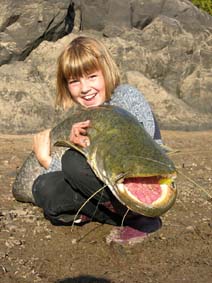
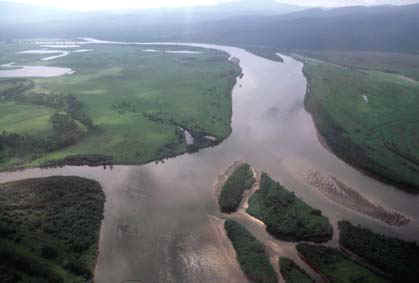
Soldatov's catfish (photo - O.Abramov) Many of the Amur tributaries are big rivers (Amgun)
Amur is about 3000 miles long, it is the tenth biggest river of the world. The lower reaches of the river begin from the mouth of big right tributary, Ussury. Here is situated the biggest city of the Russian Far East, Khabarovsk. Lower Amur is a very big river. Downstream from Khabarovsk it has low gradient and flows mostly on sand. Countless creeks and channels, pools and islands, lakes and sloughs form an enormous labyrinth, where it is easy to get lost. Most of my life I have studied salmonid fish, worked in the North, and fished in mountainous rivers. Over there everything is much simpler: easy to read the water and to understand, where to cast. When I began to fish the Amur, I was astonished by vast expanse of monotonous murky water. Many of Amur fish are true pelagic species, which are not connected with the shores of bottom. Their movements in the main channel and in the floodplain are regulated by many factors, some of which are not yet discovered. Amur is a very complicated and unusual aquatic ecosystem.
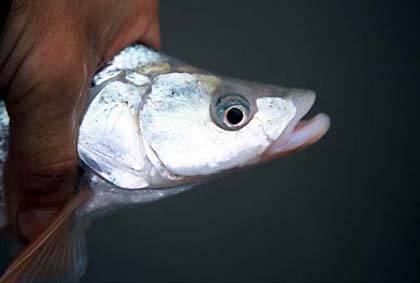
Head of the Mongolian redfin - one of the predators of the Amur floodplain
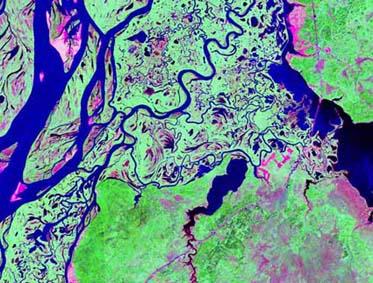
Look at the map of a small part of the Lower Amur floodplain near Pir and Gassi Lakes (downstream from Khabarovsk).
Every thin blue line is a big channel. The main Amur channel in the left part of the picture is about 2 miles wide...
However, this complicated channel system is "working" only when it is enough water in the river. In the low water period some of the channels and many floodplain lakes dry out or separate from the main river channel. When flying over Amur in low water period, you do not see much water - mostly sand. Sandy spits and islands cover most of the floodplain. During the floods, which occur mostly in August and beginning of September, there is almost no sand in the sight: all shallows are flooded, and the width of the river is many miles! Only shallow bands of willow and oak groves on the highest islands are visible.
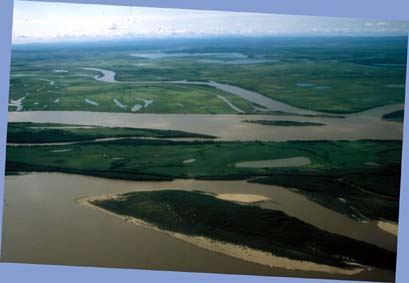
Amur in Khabarovsk area (average water level)
The situation with the environment in Lower Amur is much worse than 20 or even 10 years ago. In Manchuria, on the Chinese territory, the human population is growing rapidly: now here live almost 100 million people. The biggest problems exist in the watershed of the biggest Amur tributary - Sungary River, which drains the Chinese territory. Some of the Russian plants and factories do not work any more, but every year the water in Amur is becoming more and more polluted. Sometimes the fish and even the water under the ice is smelling with phenol or other unnatural filth. Besides that, in the last years both Russians and Chinese were increasing the fishing intensity. Many of the dwellers of the Russian villages along Amur do not have other source of income, and are trying to catch and sell fish. They are using mostly cheap gillnets brought from China. Add to this factor the impacts from large scale logging in many Amur tributaries and from placer gold mining, which cause discharge of huge amounts of suspended sediments... Regardless to all these horrors, many species of Amur fish are quite numerous. Sportfishing near Khabarovsk is still rather good. For how long will this last?
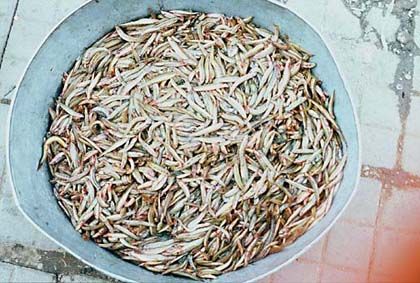
At the fish market in the Chinese city of Fuyuan, situated on the right bank of Amur above Khabarovsk, This is a huge wash-basin
filled with spiny loaches. Not far you will see fishermen selling minnows and other little fish for food. If the people will continue to fish
in the Russian part of the Amur the way they do now, quite soon we will also have to eat spiny loaches and minnows...
In Amur there are many strange looking creatures (this is three-lip)
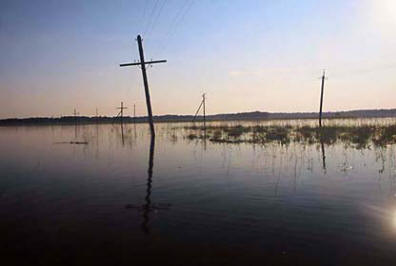
A flat valley of the Kur River (Lower Amur) in a flood.
Predatory fish species in Amur are very diverse. Predators can attack fish in winter or summer, close to the bank and far from it, near the bottom or on the surface, in open areas and in weeds. Lots of omnivorous fish species eat fish as well.
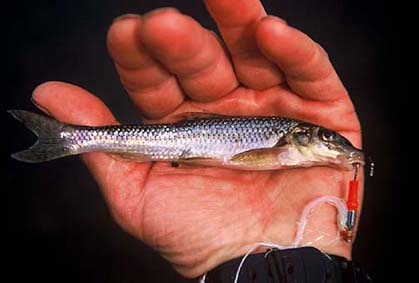
A gobio, caught with a weighted streamer.
A fish living in Amur has high probability to become food of another fish. This is why most of the Amur fish species are well protected by huge, often barbed and even poisonous spines. A spine in the dorsal fin have sawbellies (these little fish are similar to European bleak), and even both of the local bream species! The high protectability of the prey forces many species of the Amur predators to eat mostly little fish.
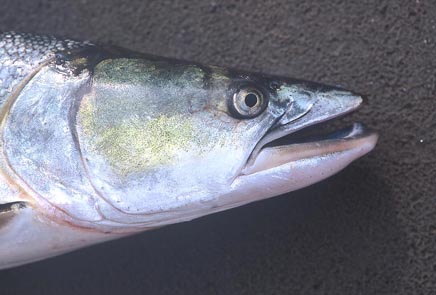
Yellowcheek is now becoming a rather numerous species
Many of Amur fish species spawn in the main river without any substrate. Their eggs and alevins are carried by the current hundreds of miles downstream. To reach the area of parental population, the fingerlings move against the current. The predators are waiting for them in convenient places like rocky shores with stronger current and whirlpools. These areas are the best places to fish for such predators as skygazer or mandarin bass.
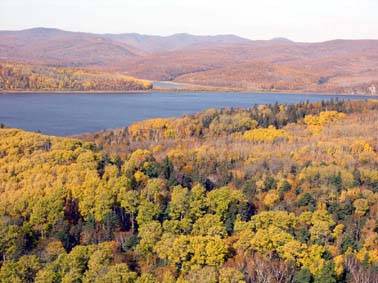
Downstream from Komsomolsk in most places Amur River has only one channel.
During the flood most of Amur fish species enter side-channels, floodplain lakes and tributaries. When the water level drops, fish start moving back into the main channels. This period many predators gather near the lake outlets and feed on fingerlings, escaping the drying areas.
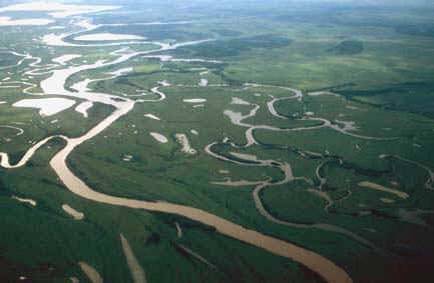
Flat Amur valley - channels near the Bolon Lake.
The main factor of success in Amur fishing is the water level. Skillful and experienced fishermen know, which channels or lakes are connected with Amur in the definite water level, which sloughs will become side-channels with current, which spits will be flooded... The water level changes; the areas which have brought you success yesterday, could stop "working".
The aforesaid concerns the waters of the Amur floodplain. There are at least two others separate types of fish communities in this huge drainage. One is the salmonid community of mountainous rivers (Siberian taimen, sharp-nose lenok, blunt-nose lenok and Amur grayling). Another one is the fish community of the lower reaches of cold rivers (Amur pike, Amur ide, flathead asp, Ussury whitefish).
Pictures of some Amur fish species
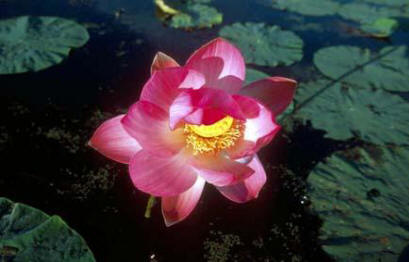
Lotos flower at the lake near Khabarovsk
Articles, posted at this site A book "Flyfishing the Russian Far East"
Home Fishing Flies Books & Articles Fishing tours About the author
FLYFISHING, OUTDOOR TRIPS, WILDERNESS PHOTOGRAPHY